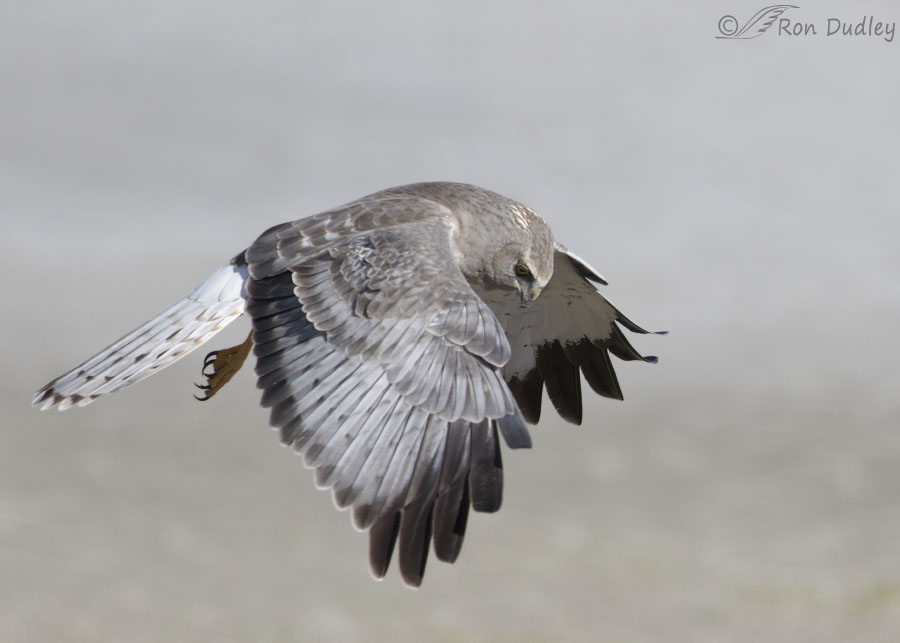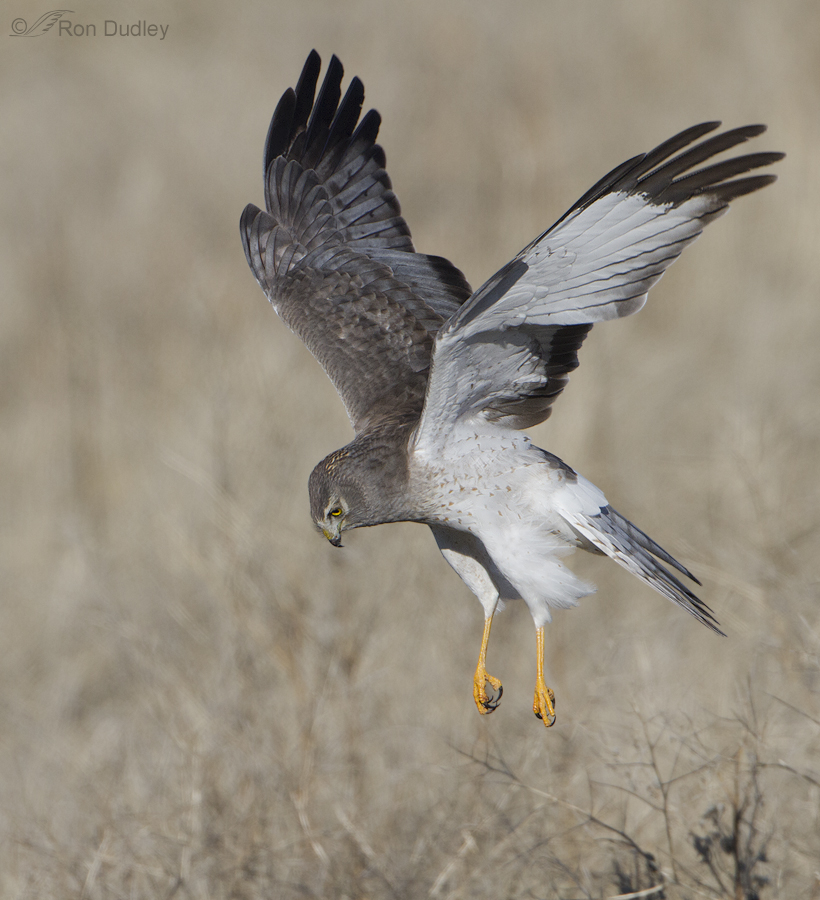This is one situation where I’ll allow one of my personal photographic ‘rules’ to be broken.

1/2500, f/7.1, ISO 400, Canon 7D Mark II, Canon EF 500mm f/4L IS II USM + EF 1.4 III Extender, not baited, set up or called in
This male Northern Harrier was hunting voles low and slow as they often do and occasionally he’d hover briefly over potential prey, or at least almost come to a full stop in the air, as he’s doing here. When they do that they’re nearly always looking straight down which can make it very difficult for the photographer to get any light in the eye. And that’s what happened here.
Typically I don’t post images without a catch light or at least light in the eye but I make exceptions if it’s a behavioral shot and to me this hunting posture simply reeks of behavior. I know of no other hawk or falcon (including kestrels) that typically hovers over prey so close to the ground – this bird was probably about 4′ above the low-growing vegetation beneath him and often they hover even lower.
Yes, I’d prefer to see more of that spectacular bright yellow eye of the male harrier than we do here but given the behavior it isn’t surprising that I can’t. If I had to choose between this near-hovering flight posture with no light in the eye and a more typical flight posture where we could see the eye better it would be a difficult decision for me to make (everything else being equal).
If I had my druthers I’d prefer to have both…
Ron
Late addendum: I’m adding the following photo in response to a request from Elmer Deloso in the comments below. Elmer asked to see a photo of a hunting harrier that included the ground below it so he could see how low they often hunt. Here we can’t see the actual ground but we can see the short vegetation that grows from it.



I’m probably far too late to this party, but I had to comment that redtails and Harris’ hawks can and do hover like that when they’re chasing mice/voles. Also, Kestrels routinely hover while hunting. Now all that said, what a gloriously beautiful shot!!
Laura, I agree. All the species you mention hover. But I said “typically so close to the ground” – meaning as often as harriers that close to the ground. I think I’ll stick with my statement… 🙂
Even without a clear view of the yellow eye or a catch light, that is one gorgeous shot. I got to watch a female Northern Harrier hunt for a brief time, and it was wonderful to see. The Gray Ghost is one of the most beautiful birds out there.
On revisiting your site, the first image reminds me I’m so glad NOT to be a mouse or a vole…(though sometimes these days I feel like one!!!)…
Must be DARk inVADAR!!!
Agreed. Harriers scarf down a LOT of voles.
Ron, both of these are absolutely beautiful photos. You can almost feel the intensity of the Northern Harrier as it hovers close to the ground to find its prey and then attack.
Hope your body is healing quickly….all parts of it!
Thank you, Ron, for your continued dedication.
Beautiful images of a beautiful bird,,,
Thanks, Patty. I’ll take credit for half that…
Fair enough!
Gorgeous! I’m happy to see one of these guys — bright eyes or not. 🙂
Good. Thanks, Marty.
I delight in your behavioural series and this shows clearly that the harrier has its eye on the prize. Definitely a winner (both the bird and the shot).
Thank you, EC.
Beautiful shots and a good opportunity to study wing morphology.
Good point, Lyle. Thanks.
Very Nice monotones. This is one bird I can’t capture nice shots of. They are so flighty I mostly have butt shots!
April, I know of no other raptor species more prone to presenting their butts to photographers than harriers. I think they delight in doing it!
I want to echo all the other comments. Beautiful and interesting because I may never have the opportunity to see in person.
I hope you eventually can see harriers in the future, Betty. I think they’re wonderful birds.
I would love to see a photo with the ground below to get a better feel of just how low these birds fly when hunting voles.
Done, Elmer. See above.
Thank you Sir Ron!
😉
I love this. The whole posture is amazing.
I like that posture a lot too, Arwen.
Ron: The hovering Northern Harrier is a very beautiful photo. Redundant after seeing the other comments, yes. But very well deserved. Thank you for sharing.
Thanks very much, Richard.
Beautiful .. love the males !!! I’m not quite as strict as you . I’ve gotton quite good at cloning in catch lights .. and the results are very pleasing . 😉
Some folks clone catch lights in, Marina. I never do. Besides, in this case adding a catch light would look unnatural because it’s virtually impossible to occur naturally because there’s no light at all on the eye.
Marvelous behavioral shot Ron!
Charlotte
Thanks, Charlotte.
Requiring a catch light in the eye is like insisting that pretty girls always smile. Reality is the most beautiful.
I love this extraordinary photo of a harrier being a harrier. Gorgeous!
Your first two sentences really made me smile, Mary. Point well taken.
This photo is stunning!! Thank you for sharing…
I’m glad you like it, Donna.
I’ll take it! Beautiful photo, Ron catch light or not..;) His eye can still be seen and the “pose” is wonderful. 🙂 “Something” got the contents of the Pee Wee nest I’ve been watching – sighhhhhhhhhh
Thanks, Judy. Sorry about your youngsters…
Yes, I’ll take any photo of these birds! I agree their hovering is a sight to behold, only to be followed by that spectacular drop down and disappearance into the grasses. I don’t know which coloring I prefer…the males or the females; it’s a pleasure to watch both. There are days when I can just sit and watch six or more of them in action. Summer photography is a little boring around here with the ‘birds of prey’ out on hiatus! 🙁
Kathy, I think most folks prefer the males, probably because adult males are less often seen most of the time.
Glad I checked back to see the additional photo you posted of him! Love to see the legs dangling like that…ready for the drop and snatch. The tones of those feathers are spectacular in both pictures.